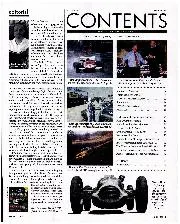
Editorial, March 2001
It's late February and a group of journalists has congregated on a chill morning to witness the unveiling and shakedown run of the latest Benetton Indycar. The Brooklands-based team's new…
Alec Issigonis didn’t like old mate John Cooper’s suggestion that his utilitarian creation was ripe for a performance upgrade and a future in motor sport. The Formula 1 team boss had seen the potential in a lightweight runaround with a wheel on each corner and his ideas found favour with the British Motor Corporation’s board. The two friends then put their heads together and the Mini Cooper was born.
The hot versions of Britain’s favourite small car built through the 1960s went on, of course, to enjoy great success on both rally stages and race tracks. But the Mini Cooper’s legend extends beyond its competition pedigree. It did much to secure the place of the Mini in the collective psyche of the motoring world. Think the Swinging Sixties — George Harrison, Mick Jagger and Steve McQueen all owned and were seen driving Coopers — and The Italian Job.

The original Minis — which weren’t really called Minis at all, but Austin Sevens and Morris Mini-Minors instead — rolled off the production line in 1959 with just 34bhp from their 848cc A-series engines. The Cooper’s longer stroke took the engine out to 997cc, and with twin SU carburettors and larger inlet valves, its power was rated at a heady 54bhp on the release of the first cars in 1961.
The performance upgrade was coupled with a close-ratio gearbox, tiny disc brakes at the front developed by Lockheed and, at least on the car tested in the pages of Motor Sport by Bill Boddy, premium Dunlop Gold Seal tyres. That’s not to forget proper door handles rather than the down to earth pulls of the first Minis.
Just 1000 cars were initially signed off in order to meet the Group 2 homologation requirements. Motor sport successes followed thick and fast: John Love won the British Saloon Car Championship title in 1962 and Pat Moss triumphed in the Tulip Rally in the Netherlands that same year.

The Mini Cooper S arrived in 1963, initially powered by a 1071cc engine and then a 1275 version, and with servo-assisted brakes thrown in.
It was the Cooper S that claimed three Monte Carlo Rally victories in the four years between 1964 and ’67 with Paddy Hopkirk, Timo Mäkinen and Rauno Aaltonen. But the world knows it would have been four but for intransigent officialdom in the 1966 event. The Cooper S enjoyed success on the track as well, Warwick Banks taking the title in what was then called the European Touring Car Challenge in 1964.
The Cooper bowed out in 1971, temporarily as it turned out, when the single Mini performance model became the squared-off Clubman 1275GT, a car with blunt aerodynamics that was slower in a straight line than the Cooper S. But production of more humble round-nose Minis continued, and the timeless shape outlived the face-lifted version. Somehow, it survived through the 1974 nationalisation of a company that now had ‘Leyland’ in its title, then years of industrial unrest, and finally denationalisation of the Rover Group in 1988.
“Somehow, it survived Leyland and industrial unrest to be reborn”
The Mini Cooper was reborn in the 1990s, first with a short run of cars dubbed the Mini Cooper RSP after the Rover Special Products skunkworks that got it back into production. Its success resulted in the Cooper S being put back into full production, now with fuel injection, in 1991.
The reinvigorated Mini brand found favour with BMW on its acquisition of Rover in 1994. The Cooper remained in production until 2000 and paved the way for an all-new Mini and, of course, hot Cooper versions.
Mini Cooper
• Price new £679 7s 3d
• Price now £10-30,000
• Engine 997cc, 8-valve in-line four
• Power 54bhp
• 0-60mph 17.1sec l Top speed 88mph
• Rivals Renault 8 Gordini, Volvo 120
• Verdict A timeless icon that hit its mark on the race track and rally stage
Knowing your models is key to a wise purchase
From popping down the shops to racing in the Monte Carlo Rally and even appearing on the big screen, the classic Mini is one of the most versatile, well-known and collectable cars ever made.
With 5.3 million sold between 1959 to 2000, there’s one model that remains on the market radar – the MkI Mini Cooper.
Launched in September 1961, two distinct variations exist – the 1000 early homologation specials, rarely seen on the open market – and later examples, which were made until 1967.
We’ve seen a few later MkIs in the classifieds and prices vary depending on where they were first delivered, whether they’ve been restored and what condition they’re in. For example, a fully restored UK, 1967 model with matching numbers is currently offered privately at £25,000.
Looking at the major auction houses, Silverstone Auctions sold a heavily rebuilt 1963 UK-registered example for £25,650 at its 2018 NEC Classic Motor Show Sale. In Paris, at this year’s Bonham’s sale, the team sold a 1963 French-registered example that was fully restored for £16,113.
Whether you have an early or a late car, you still own a piece of motoring history, and you can’t put a price on that. Or can you?
David Bond, Managing Director, Footman James
